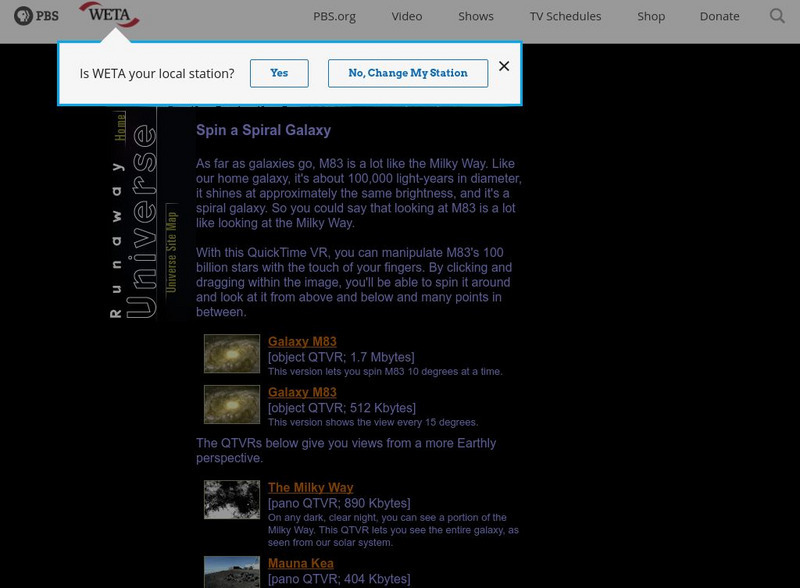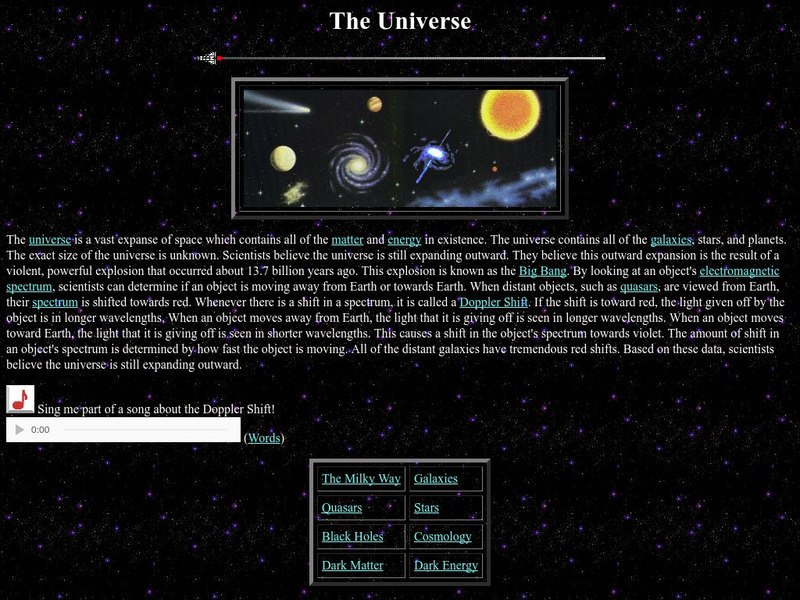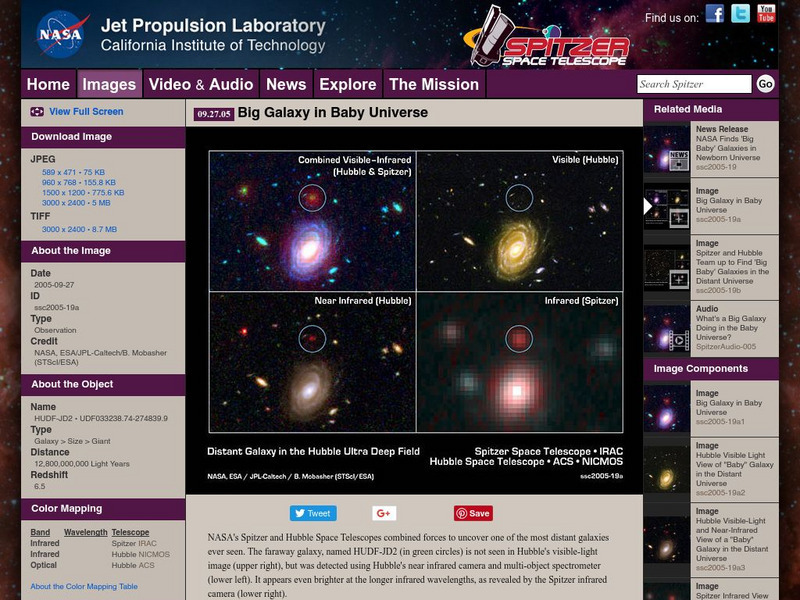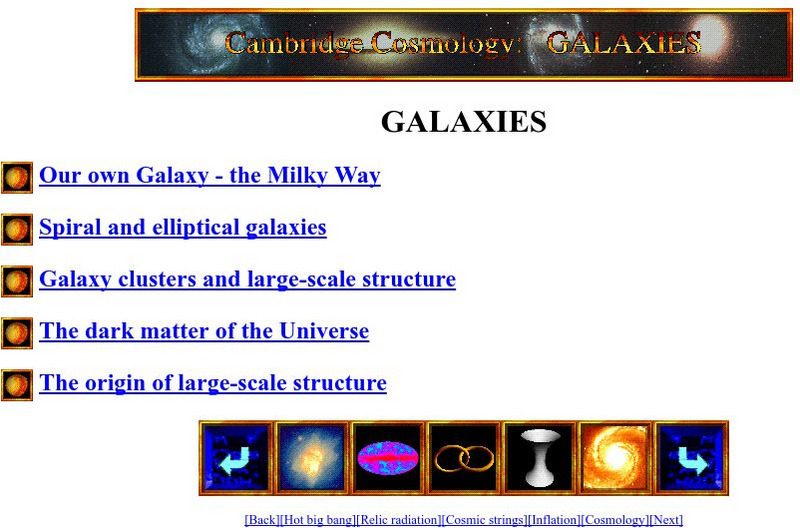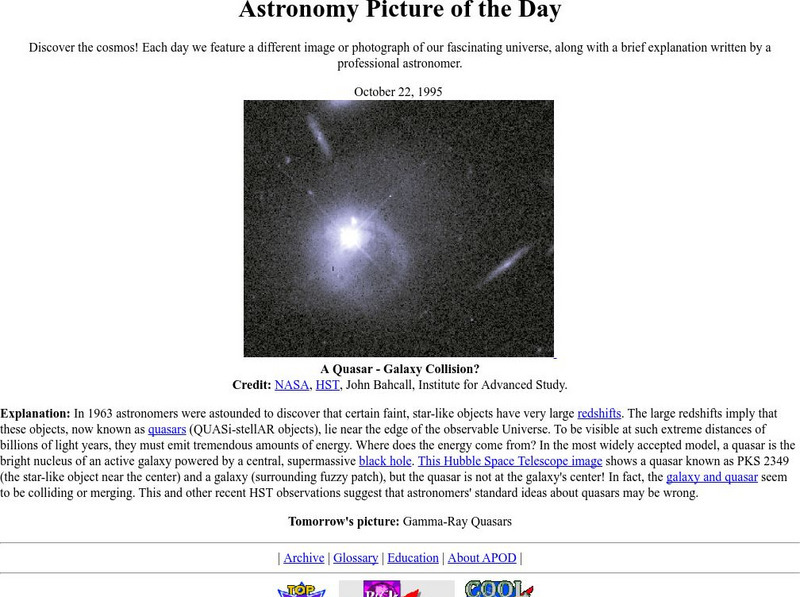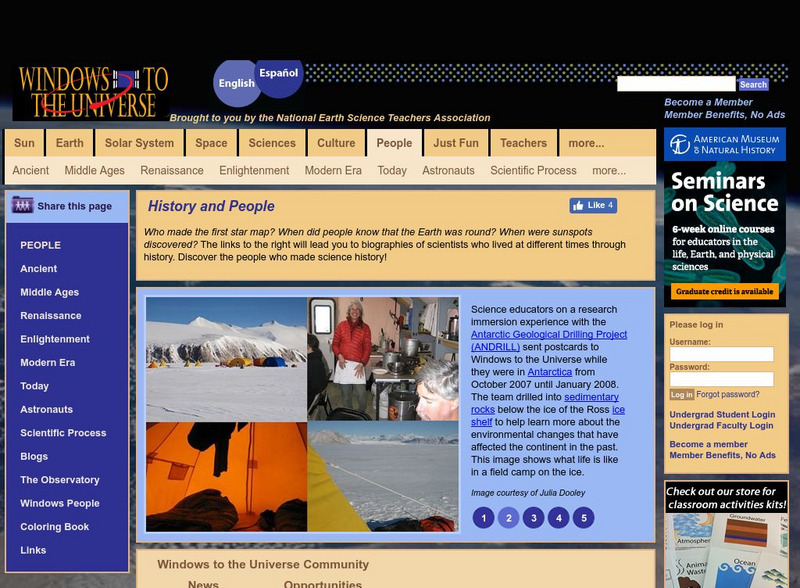PBS
Pbs Nova Online: Spin a Spiral Galaxy
PBS site provides various views of spiral galaxies. (Quick Time required) With this technology, you can manipulate the image to spin it around and look at it from various angles.
Space Telescope Science Institute
Nasa: Hubble Space Telescope: Galaxies
At this site from HubbleSite you can learn all about galaxies and black holes. Click on the movie link and discover how old the universe is or study about what happens when two galaxies collide!
Australian Museum
Australian Museum: The Earth: The Universe
Basic information about the universe, its origin and composition. Also includes information about galaxies, stars, and the sun.
Khan Academy
Khan Academy: Answers to Exploration Questions: Galaxies
Answers to the exploration questions about galaxies can be found on this site.
TED Talks
Ted: Ted Ed: How Small Are We in the Scale of the Universe?
In 1995, scientists pointed the Hubble Telescope at an area of the sky near the Big Dipper. The location was apparently empty, and the whole endeavor was risky- what, if anything, was going to show up? But what came back was nothing...
TED Talks
Ted: Ted Ed: What We Can Learn From Galaxies Far, Far Away
By studying the properties of the universe's largest pieces we can learn quite a lot about our own world and galaxy. [6:43]
CK-12 Foundation
Ck 12: Earth Science: Expansion of the Universe
[Free Registration/Login may be required to access all resource tools.] Recognize how redshift suggests the universe is expanding.
NASA
Nasa Star Child: The Universe (Level 2)
This site provides a description of the universe and what it contains. Includes links to definitions, activities, and an audio song. Printable version available.
California Institute of Technology
Spitzer Space Telescope: Big Galaxy in Baby Universe
This image, titled "Big Galaxy in Baby Universe" features an infrared picture in four parts of a distant galaxy. The text under the image details various specifics about the picture.
Other
University of Cambridge Cosmology: Galaxies
This site from the University of Cambridge allows you to view information on spiral, elliptical, and Milky Way galaxies, as well as galaxy clusters. Provides basic facts about each one.
Space Telescope Science Institute
Galaxy Hunter: A Cosmic Photo Safari
Travel the universe and learn about galaxies. Investigate Hubble Deep Field observations to learn more.
University of California
University of California Berkeley: Classifying Galaxies
Find out how galaxies are classified and then see if you can apply that knowledge to identify the different types of galaxies. In addition to explaining Hubble's galaxy classification system, the site has links to Hubble Space Telescope...
Other
University of Leicester: Irregular Galaxies
Provides a general overview of irregular galaxies, including a specific look at type I and type II irregulars.
Other
University of Leicester: Spiral Galaxies
Provides a general overview of spiral galaxies, including descriptions of the different classes of spiral galaxy.
Other
Sloan Digital Sky Survey: Galaxy Zoo
Explore the universe like you have never seen it. Take part in classifying images of galaxies taken from the Hubble telescope archives. This is a crowdsourced scientific research project.
Harvard University
Chandra X Ray Observatory: Video Podcasts: The Incredible Two Inch Universe
A set of podcasts outlining a four-step process for understanding the vastness of our universe, from the vicinity of the Earth and Moon, out into distant galaxies. Downloadable instructions and a handout are included, as well as...
NASA
Astronomy Picture of the Day: Quasar Galaxy Collision
An image of a quasar. The large redshifts imply that quasars lie near the edge of the observable universe and must emit tremendous amounts of energy. There are also many embedded links to related topics.
NASA
Nasa: Imagine the Universe: Fa Qs on Quasars
A list of answers to many questions related to quasars and active galaxies.
National Earth Science Teachers Association
Windows to the Universe: History & People
Biographies of people throughout history who looked at the sky and wondered what was there. Links to a detailed description of the planets and interactive activities.
Sonoma State University
Sonoma State University: 1938 Bruce Medalist: Edwin Hubble
Site honoring the winners of the Catherine Wolf Bruce medal for lifetime contributions to astronomy. Edwin Hubble, the award winner in 1938, is highlighted in a biography.
Space Telescope Science Institute
Nasa: Hubble Space Telescope: Universe
At this site from HubbleSite you can discover the universe by taking a look back toward the beginning of time. Site contains links to information on planets, stars, galaxies, and much more.
TED Talks
Ted: Ted Ed: Could Human Civilization Spread Across the Whole Galaxy?
Could human civilization eventually spread across the whole Milky Way galaxy? Could we move beyond our small, blue planet to establish colonies in the multitude of star systems out there? These questions are pretty daunting, but their...
Smithsonian Institution
Smithsonian Learning Lab: The Universe, an Introduction
Start with the questions all students ask: How big is the universe, how far away are the planets and stars, how did they form and when, how do they move and why? Build on their natural curiosity. The Smithsonian, in cooperation with...
American Museum of Natural History
American Museum of Natural History: O Logy: How Did the Universe Begin?
Bite-size introduction to two scientists-Hubble and Lemaitre-who played key roles in formulating the theory of the origin of the universe known as the big bang. Includes an interactive timeline on which you can plot out the approximate...
Other popular searches
- Galaxy Galaxies Universe
- Galaxies in the Universe
- The Universe and Galaxies
- Universe Galaxies Stars
- Galaxies and Universe


